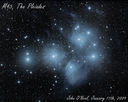John O'Neal's Messier Objects
|
|
|

Messier 51, the Whirlpool Galaxy52 views
|
|

Messier 57, The Ring Nebula50 views
|
|

64 views
|
|

Messier 1356 views
|
|

Messier 22, a Globular Cluster in Sagattarius46 views
|
|

Messier 27, The Dumbbell Nebula45 views
|
|

Messier 31, The Great Andromeda Galaxy47 views
|
|

Messier 42, The Great Orion Nebula84 viewsThe Orion Nebula (also known as Messier 42, M42, or NGC 1976) is a diffuse nebula situated south of Orion's Belt in the constellation of Orion.
It is one of the brightest nebulae, and is visible to the naked eye in the night sky. M42 is located at a distance of 1,344 ± 20 light years and is the closest region of massive star formation to Earth.
The M42 nebula is estimated to be 24 light years across. It has a mass of about 2000 times the mass of the Sun.
|
|

Messier 17, TheSwan Nebula50 viewsThe Omega Nebula, also known as the Swan Nebula, Checkmark Nebula, Lobster Nebula, and the Horseshoe Nebula (catalogued as Messier 17 or M17 and as NGC 6618) is an H II region in the constellation Sagittarius.
It was discovered by Philippe Loys de Chéseaux in 1745. Charles Messier catalogued it in 1764. It is located in the rich starfields of the Sagittarius area of the Milky Way.
|
|

M81 and M8222 views
|
|

The June 9th, 2011 Supernova Explosion in M5121 viewsUsually Supernovae are dim and isolated to some obscure part of the sky, making them all to difficult to find and image. This particular one, however went out of it's way to aid us in finding it. Not only did it get quite bright, it positioned itself in a well known, easy to locate Galaxy! How cool is that?
|
|

Messier 45, The Pleiades or Seven Sisters31 views
|
|
|
|
